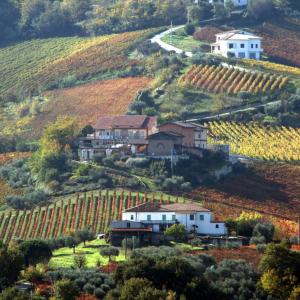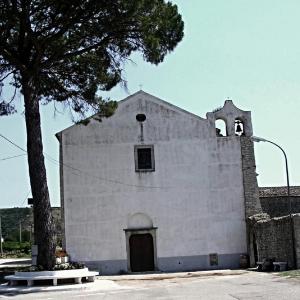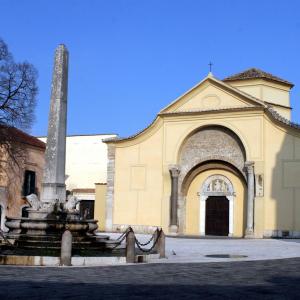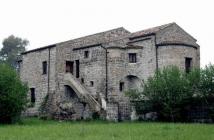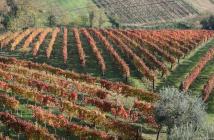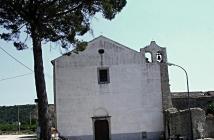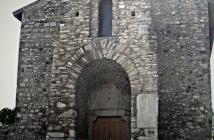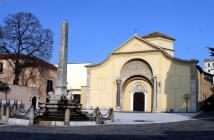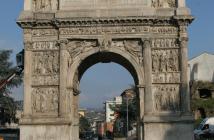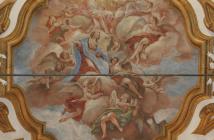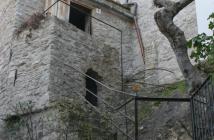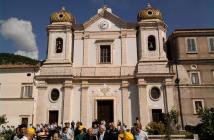15,4 km
We take the Via Appia Traiana, which unfortunately in the first stretch has been overlaid by a new state road, with no alternatives available, and leave it after a few kilometres, to take secondary roads that lead us to the discovery of a rolling, sweet and varied rural landscape, with vineyards, olive groves and pastures as far as the eye can see. With its boundless horizons, the landscape is the main interest of this stage of the itinerary.
We reach Pietrelcina, located on the bend of a tributary of the Tammaro river. This town is famous around the world because of Francesco Forgione, Padre Pio da Pietrelcina, being born here on May 25, 1887. He was canonized by Pope John Paul II.
Pietrelcina, perched on a rocky outcrop, is a rural village of ancient origins that still retains a distinctive charm. It was first mentioned in a document of 1101. Through the centuries the village had different feudal lords, among them the Caracciolo, D'Aquino and Cafara families, and the famous jurist Bartolomeo Camerario. Since the Unification of Italy in1861, it has belonged to the Province of Benevento.
Not to be missed:
- Monastery of the Capuchin Friars with adjoining Museum
- Church of S. Maria degli Angeli
- Church of S. Anna
- Birthplace of Saint Pio
- The Forgione Farm at Piana Romana, with the elm tree under which the Saint received the Stigmata.
Just off the route, it is worth visiting the Municipality of Cerreto Sannita, a town that was entirely rebuilt after the terrible earthquake of 1688. It still displays the original urban layout and is famous for its traditional production of artistic ceramics.
The first documented news about the origins of the town date back to the 12th century, in the Norman era, when it belonged to the Sanframondo family. It then became a fief of the Carafa family, who kept possession of it until the abolition of feudalism. First annexed to the Province of Terra del Lavoro, after the Unification of Italy it became part of the Province of Benevento.
Not to be missed:
- Urban centre rich in history and architectural heritage of great value and with a very distinctive urban layout
- Cathedral with adjoining Bishop's Palace and Seminary
- Collegiata di S. Martino church overlooking the homonymous square
- Church of S. Gennaro, seat of the Museum of Sacred Art
- Convent of S. Antonio
- Remains of the ancient village of Cerreto and, further down the valley, Roman bridge called Hannibal's Bridge
- Museum of ancient and modern ceramics
- Palazzo del Genio
- The Morgia Sant'Angelo boulder, also called "Lioness"
- Convent and Sanctuary of Santa Maria delle Grazie
Well worth a visit is also Guardia Sanframondi, a town of Longobard and Norman origins, which has preserved its characteristic Medieval appearance. The current town was built around the castle commissioned in 1139 by the Norman Raone, founder of the Sanframondo family. Recently restored, the fortress retains its original majesty and grandeur. The village belonged first to the Sanframondo family, until 1483, then to the Carafa family, who kept possession of it until the abolition of feudalism in 1806.
The town is located among the vineyards and olive groves that cover every hill and corner of this territory. This is a land of famous and homonymous wines of controlled origin, which represent the main economic resource of the town.
The Sanctuary of the Assunta holds, among other works of art, a wooden statue of the Virgin, in honour of which Penitential Rites are carried out every seven years. Because of their great mystical and folkloristic interest, these rites attract tourists and believers from around the world and are also the subject of anthropological studies and research.
Not to be missed:
- Historic centre
- Norman Castle
- Sanctuary - Basilica dell'Assunta
- Basilica of S. Sebastiano
- Municipal museum
Nearby, set in a green rolling landscape, marked by straight rows of vines as far as the eye can see, is Castelvenere.
Various sites bear witness to the continued presence of human settlements in this area since Prehistoric times. A famous Longobard centre, it is renowned as the birthplace of Saint Barbatus, Bishop of Benevento, responsible for the conversion of the Longobards to Christianity.
It was a fief first of the Sanframondo and later of the Carafa family, who kept possession of it until the abolition of feudalism. After the Unification of Italy it was annexed to the Province of Benevento.
Not to be missed:
- Church of S. Nicola
- Church of Santa Maria della Foresta
- Tufa cellars
- Ancient town centre
Travelling times
On foot: 4 hours
By bike: 1 hour
By car: 40 minutes
Road surface: paved
Difficulty level: medium

 View Interactive Map
View Interactive Map



